Samsung Droid Charge Review - Droid Goes LTE
by Brian Klug on June 22, 2011 7:47 AM EST- Posted in
- Smartphones
- Samsung
- LTE
- 4G
- Droid Charge
- Mobile
Cellular performance on 4G LTE is actually quite good with the Charge. Samsung’s CMC220 seems to be a top-notch performer among the LTE basebands we’ve seen thus far on Verizon’s LTE network. I performed all my testing in the Phoenix, AZ and surrounding area market, and the Los Angeles, CA market. I ran 361 tests on the Charge connected to Verizon 4G LTE, and like we’ve done before have them reported below in histogram form.
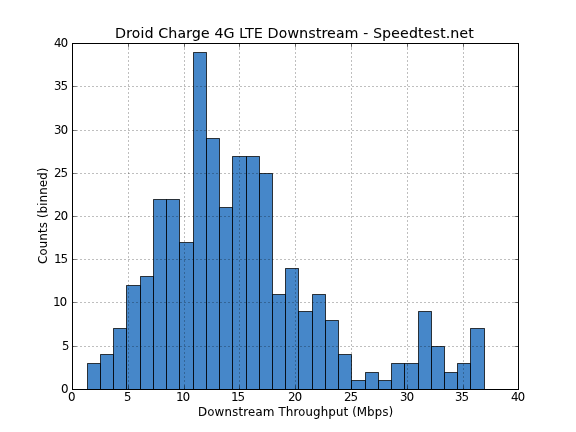
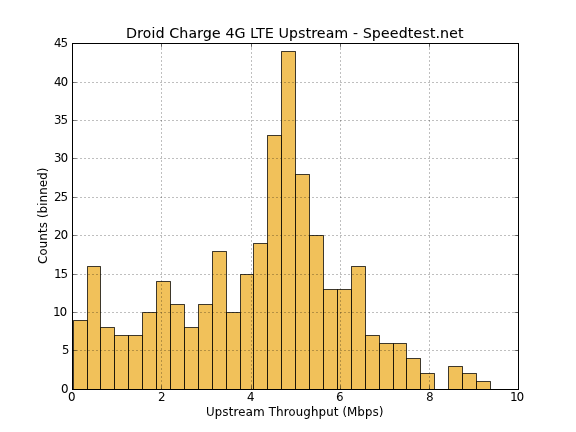
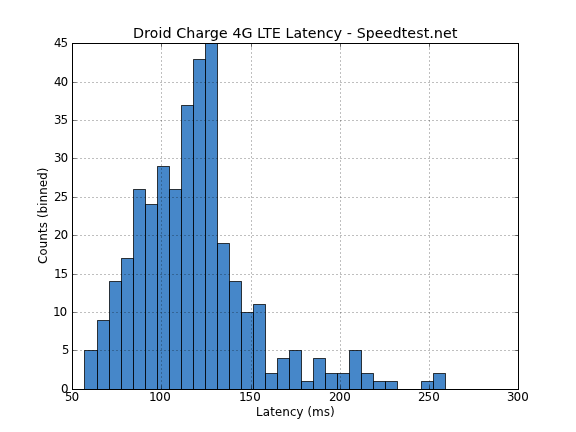
It’s really nice to see a very distinct normal distribution emerging on the downstream throughput tests, with a standard deviation about 5.5 Mbps centered around 13.0 Mbps. I saw a maximum downstream speed of 36.8 Mbps to speedtest.net’s LA server, and an average of 15.2 Mbps. Upstream throughput is likewise starting to show something of a distribution centered around 5, but the distribution is flatter here. Keep in mind that we have a lot more data here for the Charge than we did the Thunderbolt, and honestly it looks like the two would have developed similar distributions with much more testing.
I also did something out of the ordinary and thought it might make an interesting thing to report alongside these results. I made a few artists available offline on the Charge in Google Music, and recorded a video of monitored throughput in System Panel, which is an Android monitoring app and task killer.
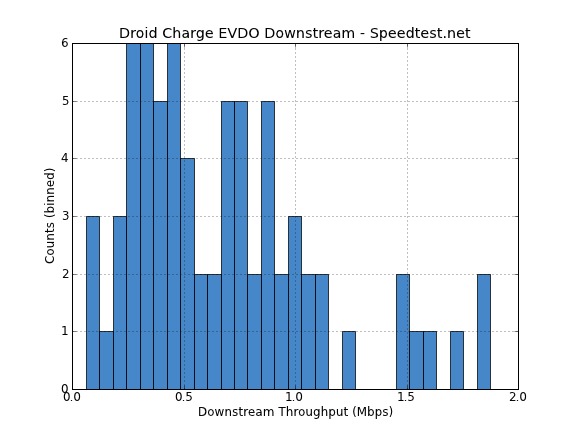
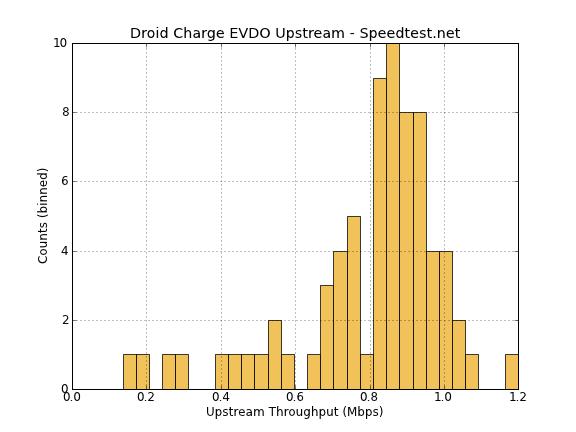
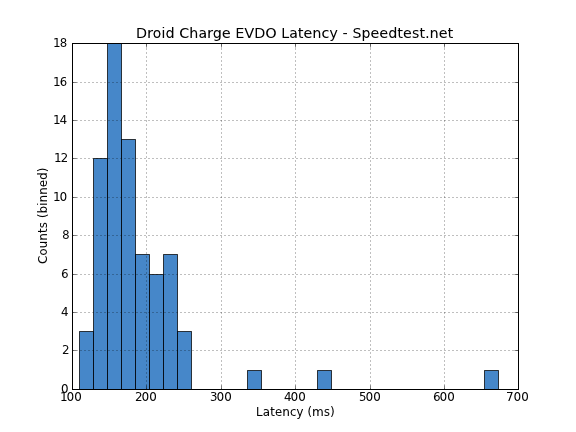
Things are a bit less interesting when it comes to EVDO performance. I’m getting used to seeing a sort of flat distribution of downstream tests ranging between 0.2 Mbps and just shy of 2 Mbps on EVDO Rev.A. On upstream the Charge shows a clustering results between 0.6 and 1.1 Mbps which actually seems a tad faster than the Thunderbolt’s. The Charge in this respect looks like it doesn’t suffer any ill consequences despite having a non Qualcomm CDMA baseband.
The Charge only reports signal from both the CMC220 LTE baseband and the VIA Telecom 7.1 in steps of 10 dBm. As a result, measuring the phone’s in-hand attenuation was a bit challenging, and ultimately not too exciting. The Charge simply isn’t prone to errant deathgrip again thanks to mandatory Rx diversity.
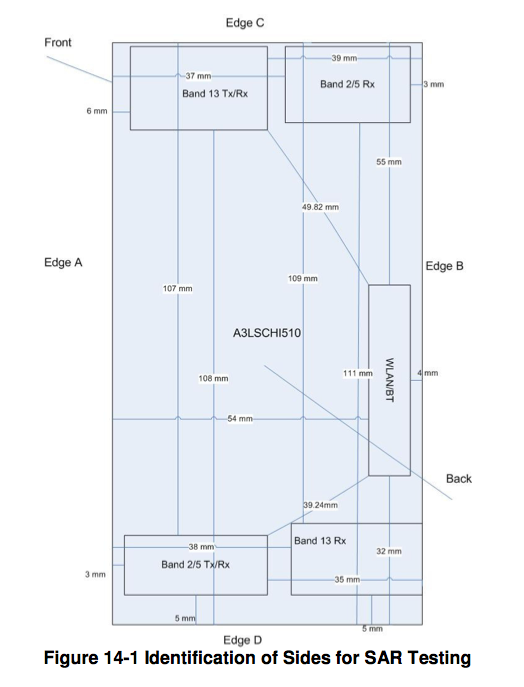
The Charge doesn’t use the same antennas to do double duty across either baseband - each gets its own set, and each does its own Rx diversity. There’s a clearly visible strip on the back of the Charge that runs alongside the right of the battery compartment which does WiFi and BT duties. The FCC supplies a nice diagram of how this all works out - Band 13 is for LTE on the CMC220, and bands 2/5 are of course for the VIA 7.5 to do CDMA/EVDO.










61 Comments
View All Comments
tuhinz - Wednesday, June 22, 2011 - link
The screenshots for the old and new builds are mixed up.Brian Klug - Wednesday, June 22, 2011 - link
I'm going to clean things up, but I ended up taking a bunch of screenshots before the update, and then after, and figured I'd just show everything.-Brian
Brian Klug - Wednesday, June 22, 2011 - link
Oops I see what you mean now - D'oh, fixed.-Brian
shaolin95 - Wednesday, June 22, 2011 - link
You should be adding a comment about vsync and benchmarks like Neocore. Most phones will be fps capped like the Galaxy S ones to 55fps or so.Regards
tayb - Wednesday, June 22, 2011 - link
Come on. This is just getting absolutely ridiculous. Android 2.3 has been out since DECEMBER. That's 7 months ago. Why are we still getting phones with an OS that was replaced more than half a year ago.dagamer34 - Wednesday, June 22, 2011 - link
To wrap this review up, if you want decent LTE battery life on your handset, wait for integrated GSM/CDMA/LTE chipsets.vision33r - Wednesday, June 22, 2011 - link
Impatient Android users would never wait since they change phones every 6 months.PeteH - Wednesday, June 22, 2011 - link
Do we know the timeframe on low-power integrated or LTE only chipsets? The limited battery life of these LTE devices in exchange for speed is a compromise I'm unwilling to make.EnerJi - Wednesday, June 22, 2011 - link
Supposedly Qualcomm has said that their next-generation integrated chipset will ship in volume towards the end of the year. Usually, phones that take advantage of said chipset will lag by several months.However, the timing is close enough to the supposed launch of the iPhone 5 (or iPhone 4S) that there's a whisper of a chance it could launch on the next iPhone... Apple has proven a willingness to pay a large up-front sum to accelerate a supplier component launch and / or lock up supply of a component that puts them ahead of the competition, and this would be a huge differentiator if they could pull it off.
Brian Klug - Wednesday, June 22, 2011 - link
Absolutely, MSM8960 with Krait and integrated LTE should be very interesting to compare with this current architecture. Hopefully battery life is much improved.-Brian